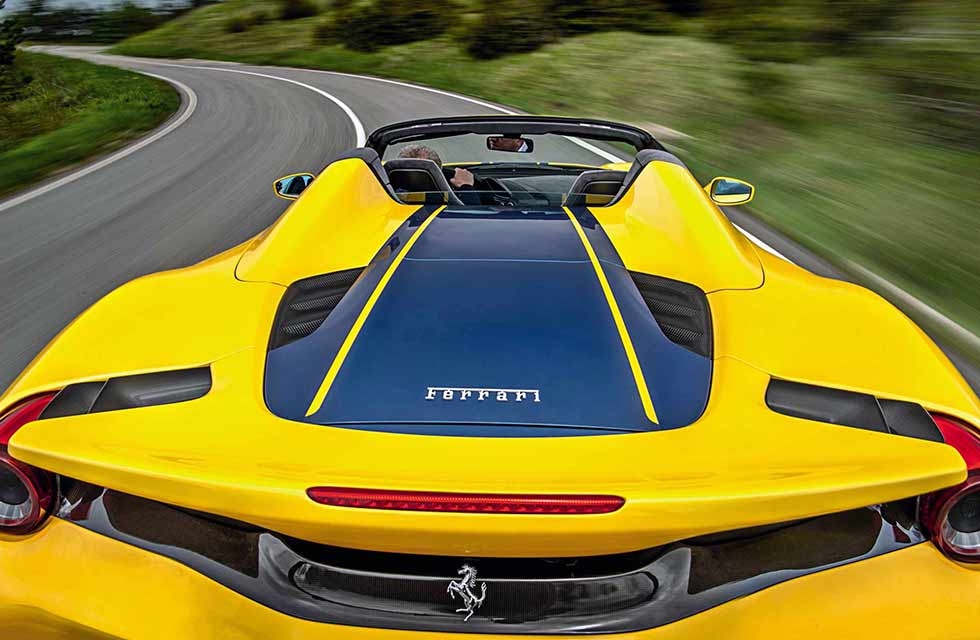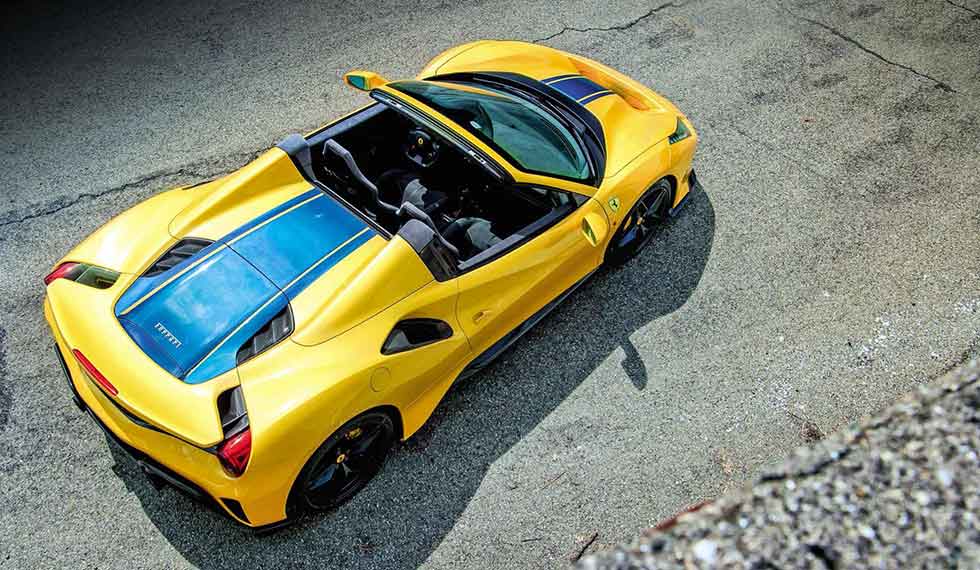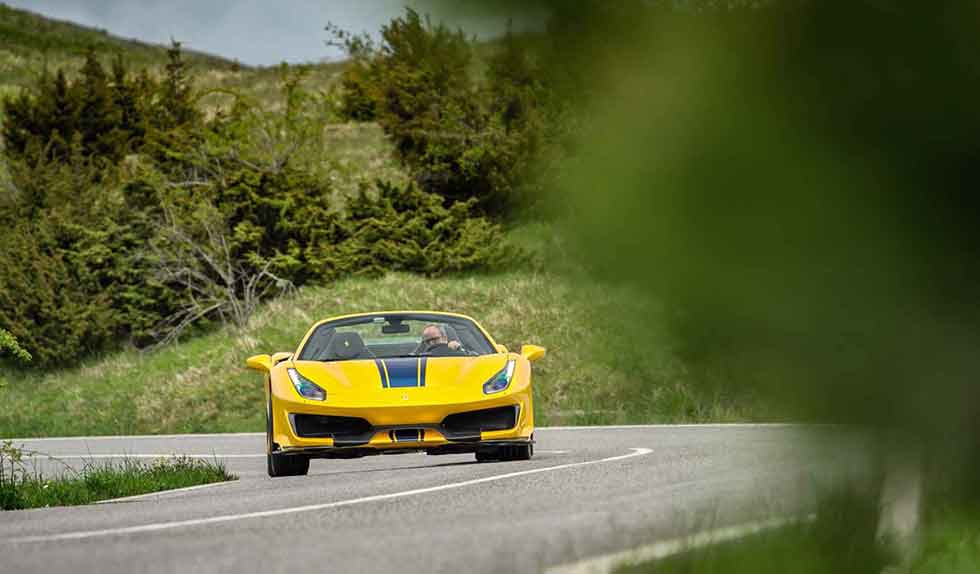
Modena Marvel. Each drive of Ferrari’s 488 Pista reveals a little bit more. But will the Spider version leave us wanting more? Words by Stuart Gallagher. Photography by Andy Morgan.
FIRST DRIVE: FERRARI 488 PISTA SPIDER
The final iteration of the rather splendid 488 is the fastest open-top car Ferrari has ever built, but could it also be one of the very best.
As flight BA542 made its final approach into Bologna airport, it struck me that I had yet to look at a weather forecast for our final destination. The view through the Airbus’s porthole window suggested this poor preparation would be the undoing of our plans.

‘EXTRACTING ALL OF ITS PERFORMANCE ON THE ROAD IS FOOL HARDY’
The patchwork landscape rushing up to meet us was less vivid verde and more reflective argento thanks to the size of the small lakes that had formed following some biblical wet weather. Which is ironic, because it was warm and sunny when Andy Morgan and I left Heathrow 90 minutes earlier.
Normally a bit of weather holds no fears. Modern cars have driver aids, more grip than they know what to do with and electrics and window seals that no longer wave white flags at the first drop of aqua. And there are filters to make miserable pictures look bright and breezy. But our car for the day has 710bhp, tyres developed from four seasons of racing at the pointy end of the grid at Le Mans, and no roof. Well, it has a roof, but it’s designed to be open.

Still, in 23 years of doing this gig, this is my first trip to Ferrari, and waiting beyond that famous faded red archway is a 488 Pista Spider. I’ve had worse days, regardless of today’s weather.
‘IT MAY BE OPEN-TOPPED, BUT THERE’S NO SOFTEN ING OF ITS HARDWARE’
In fixed-roof form, Ferrari’s latest mid-engined special has perplexed evo. On the car’s international launch, deputy editor Adam Towler was impressed with just how competent it was when faced with the mountain of performance it produced; he concluded by saying it was one of the greatest cars Ferrari had made. And it is. But it’s yet to prove to us it’s one ofthe all-time great cars.

On eCoty its lack of engagement and character lost it votes to competitors in the form of Porsche’s 911GT2 RS 991.2 and McLaren’s 600LT, both of which offered a greater connection between driver and car no matter what speed they found themselves travelling at. The Pista? Unless its Michelin Cup 2s were having a bare-knuckle fight with the tarmac there were times during eCoty when many of us felt that it was more like a highly polished 488 GTB than a Speciale successor.
Then last month’s road-racing spectacular came along, and with it more wheel time with the Pista; more miles to be exposed to its talents without the getting-to-know-you introductions slowing you down. And it transpires more Pista time is a good thing. (Who would have thought it?) It unlocks the nuances that Ferrari has worked so hard at perfecting. Still incredibly track-focused, the 488 Pista wormed its way into our psyche and up a position or two in our mentally stored log of the very best driver’s cars.
Which brings us to the next chapter in the Pista’s story – the Spider. The quick synopsis would be to describe it as a Pista coupe with a retractable roof, but this would be to undersell this strand of 488 by a wholly unacceptable amount. Along the lines of claiming that Ferrari’s current FI woes are down to Sebastian Vettel and him alone.
The coupe Pista is more of a calmed-down 488 Challenge or GTE race car than it is a GTB hot-rod, and it’s no different for the Spider, which retains the 3.9-litre twin-turbo V8 (recently crowned the world’s best engine for the fourth time) and all its 710bhp, making it the quickest open-top Ferrari of all time with its 2.9sec 0-62mph time and 1min 21.5sec lap of Fiorano. The latter is aided by the engine’s ‘wall effect’ rev limiter, which rather than cutting back power as the limiter approaches, allows the engine to give everything its got until the 8000rpm red line – which is also where the full 710bhp arrives – but then prevents the revs from climbing any further. This in itself gives the Pista a couple of tenths advantage around the company’s test track over a 488 GTB.
Dynamically the Pista Spider is as per the Pista, with the latest Ferrari Dynamic Enhancer optimised for the increased levels of performance and the 40kg weight saving over a regular 488 Spider (at 1485kg the Pista Spider weighs exactly 100kg more than the fixed-roof Pista). The Pista Spider may have been developed more as a road car than a track car, but with a brake servo from the Challenge race car and Ferrari’s carbon-ceramic brakes, Michelin’s latest Pilot Sport Cup 2 tyre, recalibrated adaptive dampers and ten per cent stiffer springs, the spec sheet certainly doesn’t suggest as much.
Especially so when you get to the work that’s gone into the aero. There’s a 20 per cent improvement in aerodynamic efficiency over the regular Spider, largely down to new active aero under the rear body and a further update to the blown spoiler first seen on the 488 GTB. Like the Pista coupe, the Spider also benefits from revised positioning of the front radiators to improve their efficiency and cooling capabilities without an additional drag penalty. By inverting the rake of the radiators the surface area increase was kept to just seven per cent despite producing the 25 per cent additional cooling required by the more powerful V8. Meanwhile, directing the escaping hot air downwards not only improves the performance of the rear intercoolers but also creates a ‘virtual fairing’ ahead of the front wheels, reducing their drag.
The engine air intakes have been relocated to the rear spoiler (as per the 488 Challenge car) from the flanks of the standard Spider, with the spoiler itself measuring 30mm higher and 40mm longer. At the front, the S-Duct introduced on the coupe Pista accounts for 18 per cent of the Spider’s downforce increase, while only causing a two per cent increase in drag. This maybe an open-top car, but there’s certainly no softening of its hardware or credentials.
As with McLaren’s Spider roofs, the Pista Spider’s could allow it to pass for a regular coupe, so well integrated and formed is the folding element. The design doesn’t jar and there are no awkward ‘what on earth were they thinking here’ elements. If a 488 coupe hadn’t parked next to ‘our’ Pista as we found new and imaginative ways to store inflexible photographic equipment inside it, it wouldn’t have taken much to convince the casual observer that the Pista Spider’s roof was indeed fixed.
Not that you get many casual observers walking along Via Abetone Inferiore at 8.30am on a Tuesday. With smartphones aloft and calls of ‘Pista Spider?’ from those not wearing an employee pass around their neck, you need to get up early to pull the wool over the tifosi’s eyes. Gear packed, map marked with roads closed due to landslides (I told you the rain had been heavy), the Pista eases us into Tuesday morning with less fuss than a Giulia Quadrifoglio in Race mode.
We curse and bemoan the lack of passion that emanates from today’s turbocharged powertrains compared to yesterday’s naturally aspirated heroes-and the few still being made today, one of the very best of which, ironically, is built the other side of the wall we’re driving alongside – but we never stop marveling at the witch craft that is Ferrari’s twin-turbo V8.
Edging out of Maranello, avoiding espresso-deprived locals and dodging pop-up road works that look less substantial than a stall selling vegan burgers in Hoxton, the Pista Spider joins the ebb and flow and takes the occasional emergency stop in its stride. It joins and runs with the autostrada seamlessly, too, supressing the expansion joints, keeping wind rush with the roof up to a minimum and brightening up late commuters’ mornings like only a yellow Ferrari in Italy can.
For all its competence at these menial tasks, this also surfaces a few doubts about the Pista and it being a little plain at normal speeds.
Even above normal speeds. It all feels a little placid, lacking the drama expected of a car with 486bhp per ton. But it’s also time to leave the autostrada, shuffle through a village or two and begin to climb.
Manettino switched to Race (Sport is the default) and Bumpy Road mode selected, the V8 shakes off its outer layer of vocal sensibleness. The gearshiftsstart nudging you backin the seat, and the throttle sharpens as the engine’s increased-diameter throttle inlets consume a larger volume of air. More lights illuminate atop the steering wheel. The Pista wakes up, the consumption of super-unleaded having the same effect on the V8 as that double espresso had on me at breakfast.
As mid-morning arrives, the Futa pass welcomes us. The recent rains have attacked its pockmarked surface further still, but this doesn’t throw the Pista off its line one bit. The sounds of light grit peppering the wheelarches tell your senses this will be a fruitless run to the top, the conditions against enjoying a 710bhp Ferrari Spider. It couldn’t be further from the experience.
With each turn, your confidence builds as intel floods back from Ferrari’s lightning-quick steering through your digits and into your nervous system. Where this was once a set-up that took a fair few miles of twists and turns to acclimatise to, it now feels second nature, as if there is an invisible wire running from your eyes to your hands to the top of those super-sticky Michelins. Third-gear corners become fourth-gear challenges, straights shorten, so too braking zones. Within a couple of hundred metres of elevation and half a dozen kilometres, the Pista Spider has snared you.
There’s cloud at the summit along with a single-digit temperature, and tour right is the Raticosa Pass and an appointment with Andy’s Nikon, which means only one thing: it’s time to open the roof. Unlike the Speedster on the previous pages, Ferrari provides a full electric tin-opener, and in the time it takes me to redirect the air vents and wind the temperature up, the roof is gone, wind howling through the cockpit. So good of Ferrari to lay on some typically British weather for us.
There’s not a great deal of additional engine drama to be heard with the roof down. More induction noise, sure, and the odd pop on the overrun, but this is no 458 Aperta when it comes to aural alchemy. It is still utterly captivating, though, running across the pass, roof down with an angry V8 doing its best to test your resolve and levels of common sense, a gearshift that can genuinely claim to be motorsport quick and a chassis that never feels anything but resolutely on your side. From the first degree of lock you apply as you commit to a corner, the front axle is primed, the Cup 2s pawing at the surface, pulling you into the apex. Lock applied, your right foot rests on the throttle, metering out the prescribed engine speed until you see your exit and apply more pressure. As you do so, the Spider pivots around your hips, its mid-engined physics joining the action, its rotation at your control. And then the throttle is wide open, the Spider locking itself onto its next target, the rear tyres gliding across the surface, their tread blocks fighting the lateral force pulling them at 90 degrees to the direction of travel.
These are not the roads on which to push the Pista’s chassis over its limit – there isn’t the room nor the high-speed radii to get it loose. But by threading it along a tight, concentrated route, where precision results in pace, the Pista Spider is able to demonstrate more of what Ferrari has designed it to do. Like the coupe, its steely focus means extracting all of its performance on the road is either foolhardy or only for the YouTube clicks, depending which side your bread is buttered. But without a doubt the Pista Spider is a supercar that possesses an immense level of talent, is capable of phenomenal speed, and will no doubt thrill and excite everyone fortunate enough to drive or be a passenger in one.
Time in a Ferrari Pista – coupe or Spider – is time well spent. And with every additional minute and mile in this complex car it allows you to get closer to it, to understand its personality better in order to enjoy it more of the time. In chasing numbers and lap times, both Pista models may come across as lacking in the passion we associate with special Ferrari models and cars with such an engineering pedigree, but both cars provide a wider glimpse of what’s on offer with every drive, allowing you to get to know them that little bit better with every drive. Until next time, Pista. Until next time.
Middle left: interior enjoys no shortage of Alcantara and carbonfibre and does without a glovebox. Right: carbon-ceramic brakes are standard, with 398mm discs front, 360mm rear; servo is taken from the 488 Challenge race car. Above: outputs of twin-turbo 3.9-litre V8 remain unchanged at 710bhp with 568lb ft of torque-good for 0-62mph in 2.9sec
2020 Ferrari 488 Pista Spider
Engine V8, 3902cc, twin-turbo
Power 710bhp @ 8000rpm
Torque 568lb ft @ 3000rpm
Weight 1485kg
Power-to-weight 486bhp/ton
0-62mph 2.9sec
Top speed 211mph
Drive-My rating 5/5






